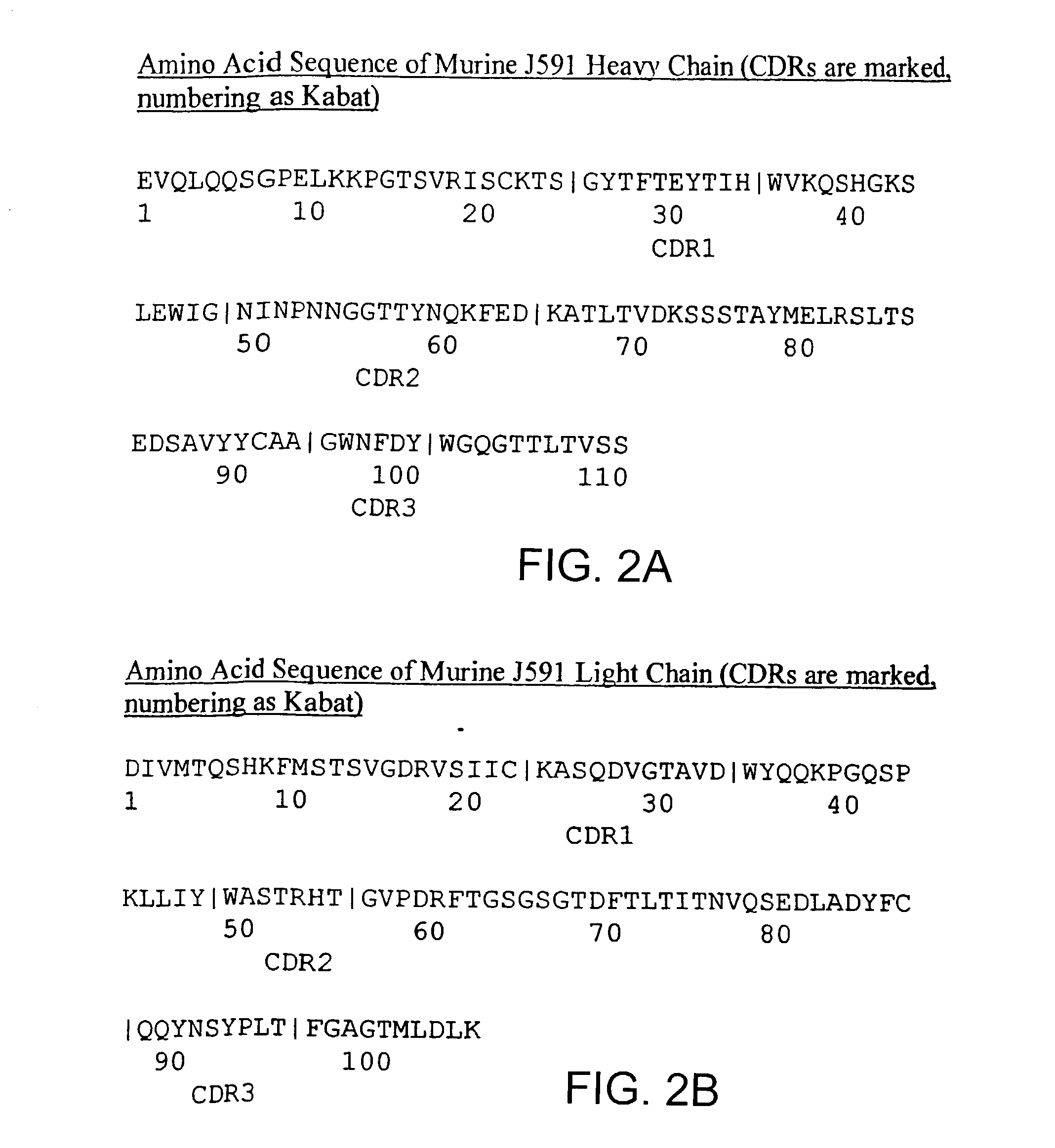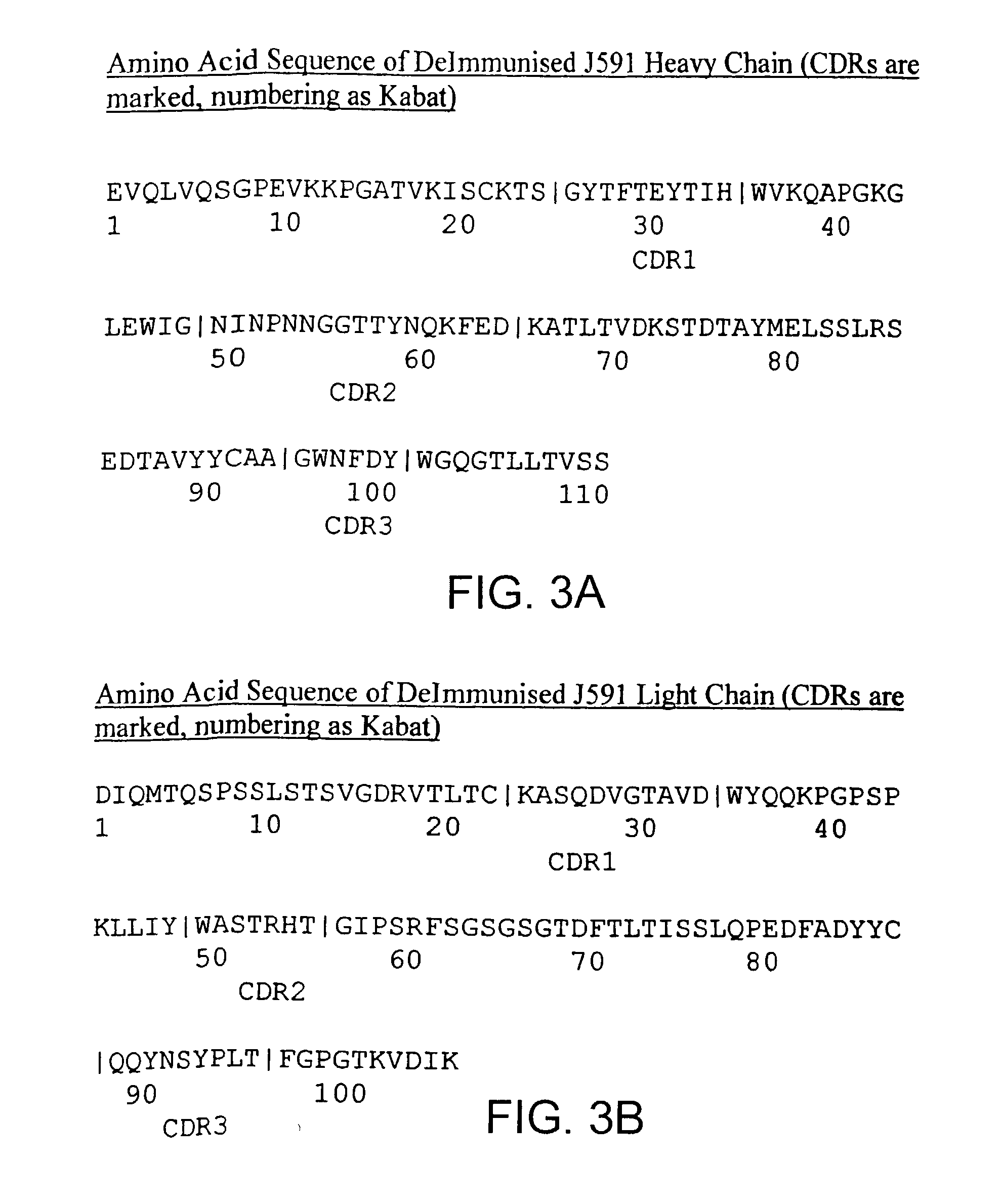Methods and compositions for treating or preventing skin disorders using binding agents specific for prostate specific membrane antigen
- Summary
- Abstract
- Description
- Claims
- Application Information
AI Technical Summary
Benefits of technology
Problems solved by technology
Method used
Image
Examples
example 1
Treatment of Psoriasis Using Deimmunized J591 Antibody
[0432]A 72 year old male with metastatic kidney cancer involving the lungs and liver was noted to have multifocal areas of psoriasis encompassing large areas of his skin, particularly on his back and arms. A note in the patient's chart indicates that his long-standing psoriasis had “worsened in the last few months.” The patient received a dose of 10 mg of deimmunized J591 by intravenous infusion over approximately 5 minutes. The deimmunized J591 was traced-labeled with 5 mCi of 111Indium for imaging purposes. Approximately 45 minutes after an uneventful infusion, the patient had shaking chills that were treated with benadryl and demerol. Due to development of wheezing and decreasing oxygen saturation, the patient also received 100 mg of solu-cortef, epinephrine and pepcid. The patient's symptoms resolved.
[0433]Approximately two weeks later, the patient was seen for his two-week follow-up appointment. The patient indicated that hi...
example 2
Treatment of Psoriasis Using Isotope-Conjugated Deimmunized J591 Antibody
[0436]A 76-year-old male with a long-standing history of psoriasis involving the left middle finger and bilateral inguinal areas received 20 mg of deimmunized J591 labeled with 10 mCi 111Indium. This initial dose was followed six days later with 20 mg deimmunized J591 labeled with 90Y (20 mCi / m2). Both administrations were by 5-minute intravenous infusions. A photograph of the psoriatic area involving the left middle finger was taken prior to the initial antibody dose (FIG. 14A). This area was unchanged at the time of the second infusion. The patient reports that within days of the second infusion, his itching virtually disappeared and over subsequent days the lesion completely healed. A follow up photograph was taken about a month after the initial dose (FIG. 14B). The patient's affected areas in the inguinal areas also substantially improved.
example 3
Enhanced Expression of PSMA in Psoriatic Lesions
[0437]Immunohistochemical stain of psoriatic lesions showed enhanced PSMA expression in basal and immediately suprabasal keratinocytes, and dermal endothelial cells, relative to non-lesional control (FIGS. 1 and 15). Increased staining was also detected in the surrounding blood vessels of psoriatic patients (FIG. 15).
[0438]Staining was performed by standard enzyme-linked immunohistochemistry. Briefly, frozen sections of skin from areas involved and uninvolved with psoriasis were washed and then incubated with murine J591 or control antibodies. After a one-hour incubation, the slides were washed and incubated with a secondary, anti-mouse Ig-enzyme reagent for an hour. The slides were washed and incubated with substrate [AEC] which converts to a red color in the presence of the enzyme, indicating where the antibody has bound.
PUM
| Property | Measurement | Unit |
|---|---|---|
| Fraction | aaaaa | aaaaa |
| Fraction | aaaaa | aaaaa |
| Fraction | aaaaa | aaaaa |
Abstract
Description
Claims
Application Information
 Login to View More
Login to View More - R&D
- Intellectual Property
- Life Sciences
- Materials
- Tech Scout
- Unparalleled Data Quality
- Higher Quality Content
- 60% Fewer Hallucinations
Browse by: Latest US Patents, China's latest patents, Technical Efficacy Thesaurus, Application Domain, Technology Topic, Popular Technical Reports.
© 2025 PatSnap. All rights reserved.Legal|Privacy policy|Modern Slavery Act Transparency Statement|Sitemap|About US| Contact US: help@patsnap.com



